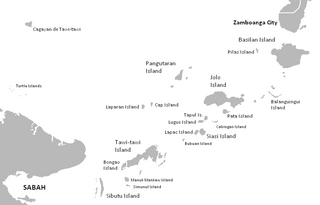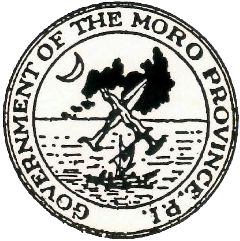
The Sulu Archipelago is a chain of islands in the Pacific Ocean, in the southwestern Philippines. The archipelago forms the northern limit of the Celebes Sea and southern limit of the Sulu Sea. The Sulu Archipelago islands are within the Mindanao island group, consisting of the Philippines provinces of Basilan, Sulu, and Tawi-Tawi; hence the archipelago is sometimes referred to as Basulta, derived from the first syllables of the three provinces.

The Sultanate of Sulu was a Sunni Muslim state that ruled the Sulu Archipelago, coastal areas of Zamboanga City and certain portions of Palawan in the today's Philippines, alongside parts of present-day Sabah and North Kalimantan in north-eastern Borneo.

The Tausūg, are an ethnic group of the Philippines and Malaysia. A small population can also be found in the northern part of North Kalimantan, Indonesia. The Tausūg are part of the wider political identity of Muslim Filipinos of western Mindanao, the Sulu archipelago, and southern Palawan, collectively referred to as the Moro people. The Tausugs originally had an independent state known as the Sultanate of Sulu, which once exercised sovereignty over the present day provinces of Basilan, Palawan, Sulu, Tawi-Tawi, Zamboanga City, eastern part of Sabah and northeastern part of North Kalimantan. They are also known in the Malay language as Suluk.

Jolo is a volcanic island in the southwest Philippines and the primary island of the province of Sulu, on which the capital of the same name is situated. It is located in the Sulu Archipelago, between Borneo and Mindanao, and has a population of approximately 500,000 people.

Jolo, officially the Municipality of Jolo, is a municipality and capital of the province of Sulu, Philippines. According to the 2020 census, it has a population of 137,266 people.

The Moro people or Bangsamoro people are the 13 Muslim-majority ethnolinguistic Austronesian groups of Mindanao, Sulu, and Palawan, native to the region known as the Bangsamoro. As Muslim-majority ethnic groups, they form the largest non-Christian population in the Philippines, and according the 2020 census conducted by the Philippine Statistics Authority, they comprise about 6.4% of the country's total population, or 6.9 million people. However, the National Commission on Muslim Filipinos (NCMF) estimates that the population is closer to about 11% of the country's total population, or 10.7 million people, attributing the difference to a number of factors.

Francisco de Tello de Guzmán was Spanish governor of the Philippines from July 14, 1596 to May 1602. He was a knight of the Order of Santiago.

Pedro Bravo de Acuña was a Spanish military officer and colonial official in the New World and the Philippines. From 1602 to 1606 he was the eleventh governor of the Philippines.

Basilan is an island province of the Philippines. It is the largest and northernmost of the major islands of the Sulu Archipelago and is located just off the southern coast of Zamboanga Peninsula. Its capital is Lamitan. Basilan is home to three main ethnic groups, the indigenous Yakans, and the later-arriving Tausugs and Zamboangueños. The Yakans and Tausugs are predominantly Muslim, while the Chavacanos are mainly Christian. There are also a number of smaller groups.
Sultan Muwallil Wasit, is the 9th Sultan of Sulu and was also known as Rajah Bongsu I. His birth name was Pangiran Shahbandar Maharajalela, and was the youngest son of former Sultan of Brunei Muhammad Hassan. He reigned in Sulu after his uncle, Sultan Batara Shah Tengah died without an heir. He was most likely sent to Sulu to end dynastic troubles there, as he was begot of the marriage of Batara Tengah's Sister, and the Sultan of Brunei. On his coming to Sulu in 1609, he was brought by his father Sultan Muhammad Hassan brought along with his royal symbol's called as "Pulau Janggi" and "Sepong Janggi". This royal symbol was a symbol of brotherhood between the Sultanate of Sulu and the Sultanate of Brunei and as a royal proof that Raja Bongsu-I really belonged to the royal family of Brunei.

The Spanish–Moro conflict was a series of battles in the Philippines lasting more than three centuries. It began during the Spanish Philippines and lasted until the Spanish–American War, when Spain finally began to subjugate the Moro people after centuries of attempts to do so. Spain ultimately conquered portions of the Mindanao and Jolo islands and turned the Sultanate of Sulu into a protectorate, establishing geographic dominance over the region until the Spanish-American War. Moro resistance continued.
The Spanish occupation of Jolo or Battle of Jolo was a military expedition in the 1630s to pacify the Moro of the Sulu Sultanate. The expedition, personally led by Sebastian de Corcuera, the then Governor-General of the Spanish East Indies was a follow-up expedition to the earlier successful campaigns against the Maguindanao Sultanate under Sultan Qudarat. It was initially successful, partly due to an epidemic within the Sultan Wasit's fort early in the campaign, resulting in the Sulu forces retreating to Tawi-Tawi.

In the Philippine history, the Lupah Sug was a predecessor state before the establishment of Sultanate of Sulu.

Najeeb Mitry Saleeby (1870-1935) was a Lebanese-American physician who served the U.S. colonial occupation of the Philippines and who became an expert on and advocate for the Muslim population of the region. He held positions as the Assistant Chief of the Bureau of Non-Christian Tribes, Superintendent of Schools, and Captain and Assistant Surgeon of the US Volunteers. He became a premier expert on the Moros, Muslim peoples from the islands of Mindanao and Sulu. Through his medical profession, advocacy for bilingual education, and critique of American imperialism, he dedicated his career to advancing Filipino welfare. He spent most of his adulthood in the Philippines and died in Baguio in 1935.
In 1596, the Spanish army launched an expedition to the island of Mindanao to conquer and pacify it; however, the expedition ended in failure and they were forced to withdraw.
The Sulu Expedition of 1630 was an unsuccessful military campaign by the Spanish Empire to capture the island of Jolo. Launched from the Spanish Philippines to suppress Sulu pirates, the expedition ended in failure.
The raids of Visayas took place in 1599 and 1600. The allied Moro fleets of Maguindanao, Buayan and Sulu conducted two raids on the Spanish-held islands of Visayas.

Sultan Harun Ar-Rashid was a sultan of Sulu from 1886 to 1894. He was confirmed a sultan by the Spanish colonial government and was appointed in September 24, 1886. His reign ended in 1894 due to the lack of support from fellow Sulus and regional unrest. He was removed from appointment by Spanish authorities.

Jamal ul-Azam, also spelled Jamalul Azam, was the sultan of Sulu from 1862 to 1881. He was infamous for his maintenance of extensive contracts with British and German traders. These were done to counter Spanish dominance in Mindanao. In 1878, he allowed Gustav Overbeck to have north Borneo.

Mohammad Pulalun Kiram was sultan of Sulu from 1844 to 1862. He succeeded his father, Jamalul Kiram I. During his reign, Spanish expedition to Sulu was led by Governor-General Narciso Claveria y Zaldua and subsequent conflict with the Spanish military under Governor-General Juan Antonio de Urbiztondo. As sultan, he was known for his political administration making the Royal House of Kiram extend its influence and fame among Sulus.













